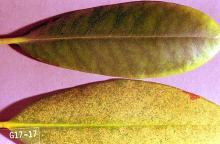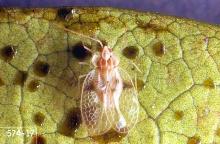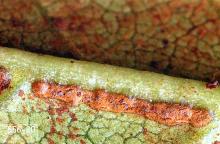Azalea lace bug (Stephanitis pyrioides)
Rhododendron lace bug (Stephanitis rhododendri)
Pest description and damage Lace bugs use piercing-sucking mouthparts to feed on individual cells, so the upper leaf surface is yellow and stippled. The underside of leaves is covered with varnish-like "tar" spots. Infestations are more severe on plants in the sun. Damage is usually apparent by early to mid-July. While almost never fatal, repeated infestations of rhododendron lace bugs may result in yellowed, sickly plants. Adult insects are whitish-tan and approximately 0.125 inch in length with lacy-looking wings. Nymphs grow to about 0.13 inch and are spiny. The damage the insects cause is similar on first inspection to that of leafhoppers but for the presence of tar spots. Identification is based on the dark markings on the thorax and wings.
For biology, life history, monitoring and management
See:
Azalea (Rhododendron)-Azalea and rhododendron lace bug
Management-chemical control
See Table 1 in:





